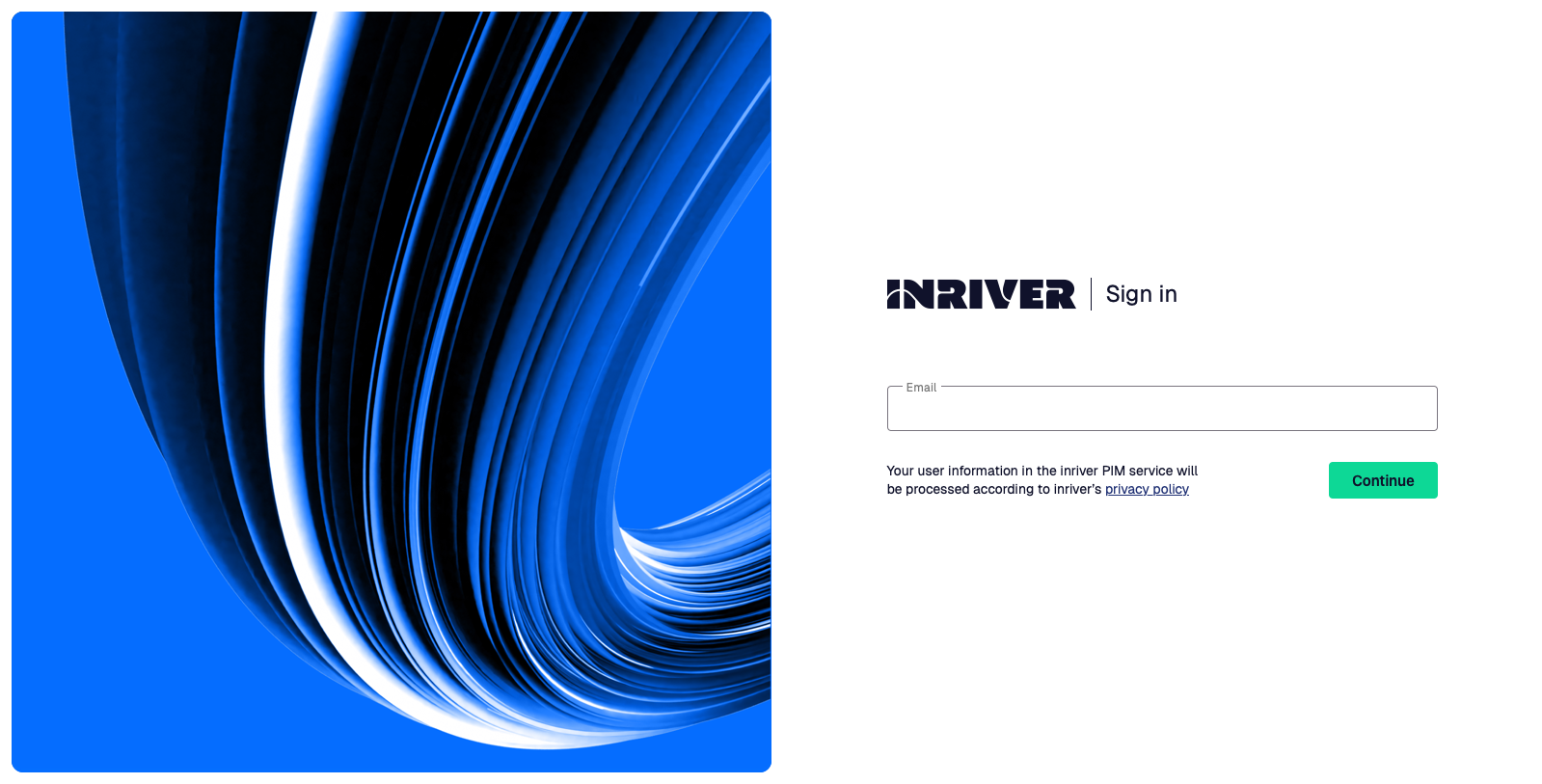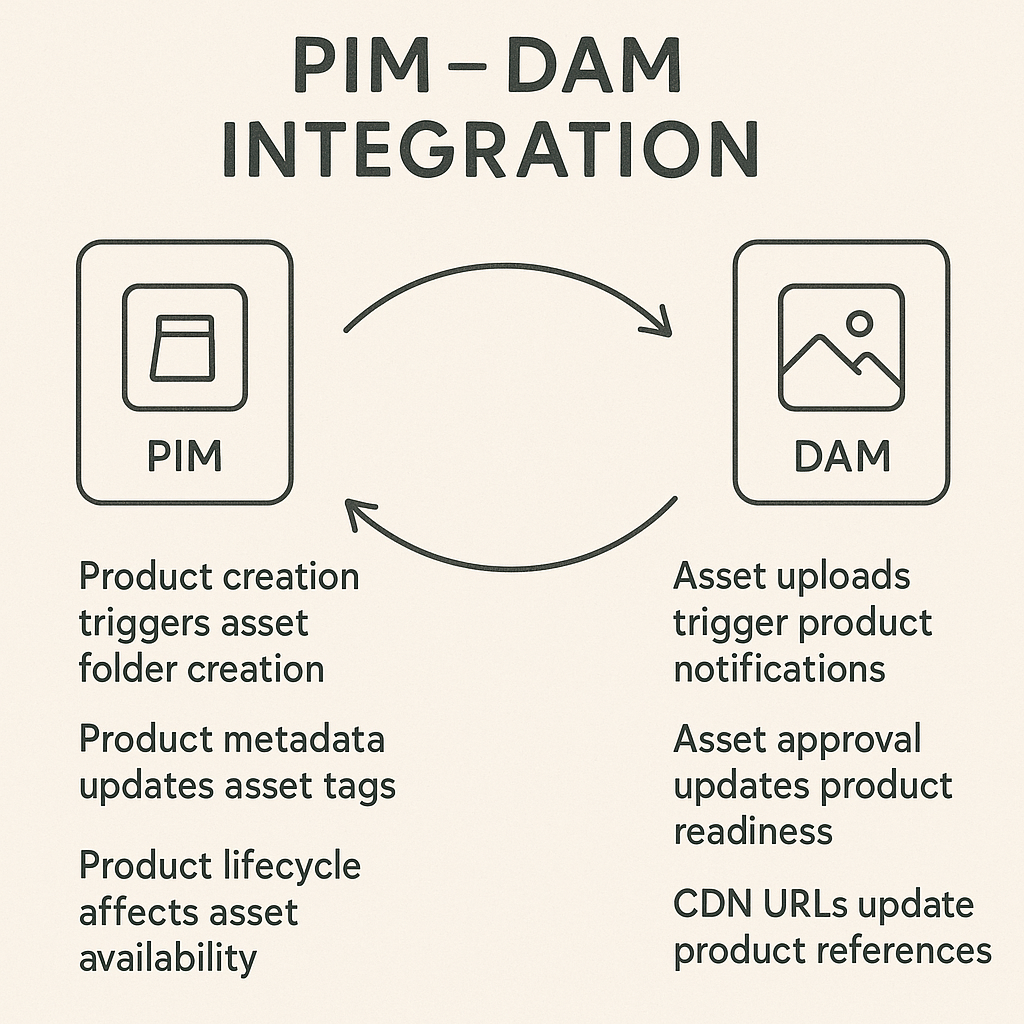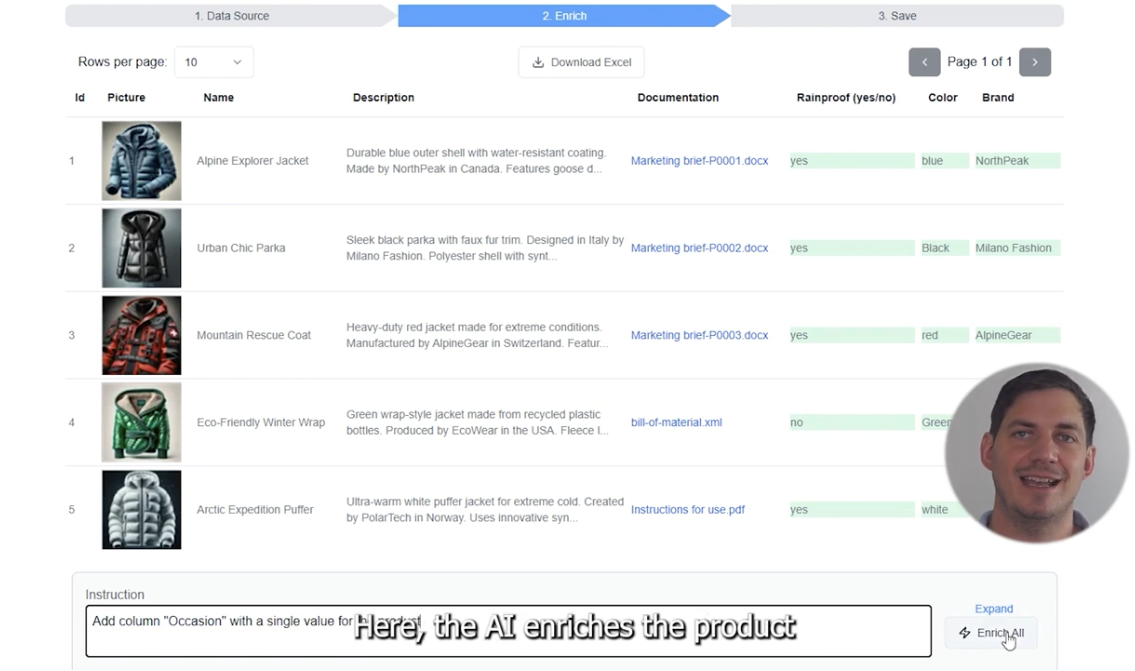Platform Overview
Inriver employs an entity-agnostic data model where any object type can be defined and managed with equal priority. This approach treats products, brands, categories, suppliers, campaigns, or any business concept as first-class entities that can be modeled with custom attributes, relationships, and workflows. Unlike traditional PIMs with hardcoded product entities, Inriver provides true flexibility for complex data modeling scenarios.
This entity-agnostic approach offers greater modeling flexibility for complex B2B scenarios where you might need to manage detailed supplier information, marketing campaigns, or regulatory data as primary entities rather than product appendages. The platform's Expression Engine uses Excel-like syntax to define rules for field values, enabling simulation of inheritance and versioning concepts.
Key Facts
- Founded: 2007
- Headquarters: Malmö, Sweden
- Approach: Entity-agnostic data modeling
- API: REST-based with comprehensive Swagger documentation
- Deployment: Cloud SaaS with Azure infrastructure

Inriver PIM login page interface
The Inriver login interface demonstrates the professional, enterprise-focused design of the platform.
Core entities in Inriver's entity-agnostic data model with configurable relationships and attributes
| Entity | Vendor Name | Description | Key Attributes | Relationships |
|---|---|---|---|---|
Product | Product Entity | Configurable entity type for products; no hardcoded structure, fully customizable | configurable fields relationships business rules | links to Items connects to Resources maps to Channels |
Item | Item Entity | Variant-level entity representing sellable SKUs with specific attributes | SKU identifier variant attributes pricing data | child of Product linked to Resources |
Resource | Resource Entity | Digital assets and media files with metadata and versioning capabilities | file data metadata versions copyright info | linked to Products/Items organized in folders |
Channel | Channel Entity | Output destinations for product data syndication and publishing | channel configuration mapping rules export settings | receives Product data defines output format |
Custom Entity | Configurable Entity | Any custom business object (Suppliers, Customers, Locations) with full modeling capabilities | custom attributes relationships business rules | configurable connections to any entity type |
New to PIM systems?
Before diving into Inriver specifics, you might want to read our detailed guide to PIM systems to understand the fundamentals and key concepts.
Read PIM Systems GuidePlatform Demo & Interface
Watch this comprehensive demo showcasing Inriver PIM covering the basic user activities: finding products, enriching products, merchandising products, and publishing products. Recorded on the cloud-hosted Inriver demo environment in May 2022.
The demo highlights Inriver's unique workarea-based workflow system, where saved searches become collaborative spaces for product enrichment teams.
"Having implemented Inriver many times, I keep coming back to it. I find the assignments, notifications, workflows, and grid views really compelling for multi-user collaboration, but it takes a bit of training to get used to."
Complete list of attribute types available in Inriver with their Inriver terms and search capabilities
| Common Name | Vendor Name | Description | Operators | Examples |
|---|---|---|---|---|
Text | String, LocaleString | String fields, with LocaleString supporting localization | Equal NotEqual BeginsWith IsEmpty IsNotEmpty Contains | Product name Description SKU |
Number | Integer, Double | Numeric fields for integers and decimal values | Equal NotEqual GreaterThan GreaterThanOrEqual LessThan LessThanOrEqual IsEmpty IsNotEmpty | Weight Price Quantity |
Boolean | Boolean | True/false checkbox field | IsTrue IsFalse IsEmpty IsNotEmpty | Is active Featured product Discontinued |
Date | DateTime | Date and time field | Equal NotEqual GreaterThan GreaterThanOrEqual LessThan LessThanOrEqual IsEmpty IsNotEmpty | Launch date Last modified Expiry date |
Single Select | CVL (single value) | Single option from controlled vocabulary list (CVL with single value setting) | ContainsAny NotContainsAny Equal NotEqual IsEmpty IsNotEmpty ContainsAll NotContainsAll | Brand Category Status |
Multi Select | CVL (multi value) | Multiple options from controlled vocabulary list (CVL with multivalue field setting enabled) | ContainsAll ContainsAny NotContainsAll NotContainsAny IsEmpty IsNotEmpty | Features Materials Certifications |
File | File | Binary file upload field | Equal NotEqual GreaterThan GreaterThanOrEqual LessThan LessThanOrEqual IsEmpty IsNotEmpty | Product image Manual PDF Video file |
Complex Object | XML | XML data stored as string with runtime performance cost for syntax validation. No XML features like path search are supported in the API. Common practice is to use text fields to store JSON and use Expression Engine or .NET extensions for JSON search | Equal NotEqual BeginsWith IsEmpty IsNotEmpty Contains | Technical specifications Structured data Configuration |
API Implementation Details
Authentication & Security
Inriver uses API key authentication with granular permissions. The .NET SDK provides strongly-typed access to all API endpoints, making integration straightforward for Microsoft-stack environments.
Query-Driven Architecture
Inriver's API follows a query-first approach where complex searches are performed via POST /v1.0.0/query with systemCriteria and dataCriteria objects. This enables sophisticated filtering by entity types, field values, and relationships. The query results return entity IDs which are then used in bulk fetch operations via POST /v1.0.0/entities:fetchdata, supporting efficient data retrieval patterns for large datasets.
Workarea Integration
The API provides native workarea support through /v1.0.0/workareafolders endpoints, allowing programmatic access to collaborative workspaces. This enables integration scenarios where external systems can participate in Inriver's workflow-driven product enrichment processes.
Entity Modeling Flexibility
Unlike traditional PIMs, Inriver has no hardcoded default entity types. Products, Items, Resources, and Channels are just predefined examples - you can create custom entity types (Suppliers, Customers, Locations) with identical modeling capabilities including all attribute types, relationships, and business rules.
Hosted Extensions & Technical Debt
Inriver supports hosted extensions that enable event handling and scheduled jobs, but these must be written in .NET Framework (not .NET Core). This technical debt is tied to SQL stored procedures used for core functionality like channel structure handling. While these extensions may appear as an "unlimited integration engine," they have performance and scalability limitations that interact unpredictably with the dynamically configured data model. Caution is strongly recommended - avoid using hosted extensions entirely, especially for critical integrations. External middleware approaches are safer and more maintainable.
Strongly Typed Framework
While the .NET API is strongly typed, the configured entity data model is only available dynamically. For creating a strongly typed framework that reflects your specific entity configuration, a .tt template can be used to generate code against your data model.
Expression Engine & Data Processing
The Expression Engine uses Excel-like syntax to define rules for field values, enabling complex business logic, inheritance simulation, and automated data validation. The Expression Engine supports JSONVALUE and XMLVALUE functions to read data with JSONPath and XPath expressions, but this functionality is only supported on string field types, not on the XML field type. This provides powerful automation capabilities for data quality and consistency when working with structured data stored in text fields.
Documentation Quality
Detailed Swagger documentation is available per tenant, with detailed endpoint descriptions and the official .NET SDK providing code examples and best practices for integration development.
API Usage Example
Example showing how to retrieve and update an entity using the Inriver .NET SDK
// Retrieve and update entity using Inriver .NET SDK
var client = new RemotingClient("https://api.productmarketingcloud.com", "<apikey>");
// Get entity by ID
var entity = await client.GetEntityAsync(12345); // product entityId
// Update entity field
entity.Fields["Name"].Data = "Updated title 2025";
// Save changes
await client.UpdateEntityAsync(entity);API Search Example: Find Entity by Attribute
Example showing how to search for an entity by a specific attribute value (e.g., SKU) using Inriver's Query-driven API.
// Search for a Product entity by its SKU value
var client = new RemotingClient("https://api.productmarketingcloud.com", "<apikey>");
var query = new Query
{
SystemCriteria = new List<SystemCriterion>
{
new SystemCriterion { Field = "EntityTypeId", Operator = "Equal", Value = "Product" }
},
DataCriteria = new List<DataCriterion>
{
new DataCriterion { Field = "ProductSKU", Operator = "Equal", Value = "SKU-12345" }
}
};
var result = await client.QueryAsync(query);
var entityId = result.EntityIds.FirstOrDefault();
if (entityId > 0)
{
var product = await client.GetEntityAsync(entityId, LoadLevel.DataOnly);
// Found entity, continue processing...
}"Inriver is extensible with both HTML templates and C# code. While both are powerful, be careful not to overdo it - most modifications are better placed in middleware with a UI utilizing the PIM headless-style."
Technical Specifications
Entity-Agnostic Approach
Inriver's architecture treats all entities as first-class citizens with identical modeling capabilities. Custom entities support all attribute types, relationships, and business rules available to built-in entity types.
Workarea-Based Workflows
Advanced search results can be saved as workareas, which become collaborative spaces where teams can be assigned specific product sets for enrichment. This workflow-centric approach drives productivity in large organizations.
Built-in DAM with CDN
Resources (digital assets) are treated as entities linked to Products and Items. The platform includes a built-in DAM with CDN that features cropping and rendering through ImageMagick console parameters. However, this CDN is not intended as a global edge delivery network like CloudFront. The platform includes automatic derivative creation, versioning, and metadata management.
Syndication Capabilities
Syndicate+ is a module enabling syndication to Amazon and other trading partners. Normal Excel export can go a long way in syndicating to marketplaces. For advanced syndication strategies, explore AI-powered marketplace optimization approaches.
Digital Shelf Analytics
Digital Shelf Analytics is a separate Inriver offering that enables analytics on data across marketplaces like Amazon. A demo with the specific marketplaces you trade with is recommended to assess the quality and relevance for your use case.
Recent Platform Updates & AI Integration
Inspire AI in Details Tab
Inriver has integrated their Inspire AI functionality directly into the most-used Enrich details tab. Users can now access generative AI capabilities through a side panel to create, enhance, translate, and save text using Large Language Models (LLMs). The new bulk-generation capability allows users to inspire or translate multiple fields simultaneously, significantly improving content creation efficiency.
Inspire AI in Table View
AI functionality is now available directly in Table View without opening individual entity pages. Users can right-click on fields to generate or translate text using Inspire's AI, enabling rapid content creation across multiple products simultaneously.
Enhanced Table View Capabilities
Table View has received significant improvements including direct media management access, allowing users to preview, download, and upload media assets without leaving the view. A new column categorization tool helps organize large data models by grouping columns (field sets, categories, locales), making navigation more efficient for complex implementations.
Shareable Workspaces
Users can now configure specific Table View layouts with custom column arrangements and save them as workspaces. These workspaces can be shared with colleagues, improving team collaboration and standardizing data views across organizations.
Workflow & Navigation Enhancements
Manual workflow triggering is now possible through right-click actions, allowing users to push entities through workflows even when automatic conditions aren't met. Enhanced entity traversal enables users to right-click and open all linked entities in separate tabs, facilitating bulk updates across related products.
Table View in Entity Relationships
Table View is now the default interface for viewing linked entities within entity pages, replacing previous list views. This provides better functionality for adding, removing, updating, and sorting linked entities with drag-and-drop capabilities between Table View and workareas.
Leverage Inriver's extensibility for smarter content syndication and seamless system integrations.
Limitations & Implementation Considerations
Steep Learning Curve
Inriver's advanced capabilities come with significant complexity. The platform requires extensive training for users and substantial implementation effort to realize its full potential. Organizations should budget for comprehensive change management and user adoption programs.
Complex Data Model Management
While the entity-agnostic approach provides flexibility, it can lead to overly complex data models that become difficult to maintain. The Expression Engine, while powerful, requires specialized knowledge and can become a bottleneck for simple changes.
Built-in DAM Limitations
The integrated DAM is not suitable for large collections of high-resolution files and the CDN capabilities are limited compared to dedicated solutions like CloudFront. Organizations with extensive digital asset requirements may need additional DAM solutions.
Completeness System Constraints
The completeness system defaults to global entity-level rules. Making completeness dependent on product types, channels, or markets requires complex workarounds through the Expression Engine, which can be challenging to maintain.
Deployment & Infrastructure
Available only as cloud SaaS on Azure infrastructure. Organizations requiring on-premises deployment or specific cloud providers have no alternatives. For pricing considerations, refer to our comprehensive SaaS negotiation guide.
Strategic considerations for Inriver implementation including AI content strategies, data architecture, security, and alternative approaches
"The completeness system defaults to a global level per entity type. Making this dependent on product types and channel/market takes many tricks, something I expect to be addressed in future roadmap updates. Additionally, versioning, draft/publish, and inheritance are modeled through the Expression Engine or extensions, something I hope to see integrated into the core product at some point."
Key Benefits & Strengths
Entity-Agnostic Architecture
Unlike traditional PIMs with hardcoded product entities, Inriver treats all entity types as configurable. This enables modeling of any business object (Suppliers, Customers, Locations) with full attribute richness and relationship capabilities.
Workarea-Driven Collaboration
Advanced search functionality creates workareas that become collaborative spaces for product enrichment teams. This workflow-centric approach improves productivity and accountability in large organizations.
Expression Engine Automation
Excel-like syntax for business rules enables complex automation, inheritance simulation, and data validation without custom development. This reduces manual work and ensures data consistency.
Built-in DAM with Limitations
Includes digital asset management with automatic derivative creation and versioning. However, it's not recommended for large collections of high-resolution files like Photoshop documents, and the CDN is not comparable to global edge delivery networks like CloudFront. Resources are treated as first-class entities with metadata capabilities.
Advanced Analytics & Syndication
Digital Shelf Analytics is a separate module that monitors channel performance and retailer compliance. Syndicate+ is another module that enables direct syndication to Amazon and other trading partners. Dashboard widgets provide visibility into productivity and data quality trends.
Flexible Entity Modeling
Custom entities have identical capabilities to built-in types, supporting complex business scenarios that require rich data modeling beyond traditional product catalogs.
Sivert Kjøller Bertelsen
PIM Implementation Consultant • Multiple Inriver implementations
"Inriver's entity-agnostic architecture is powerful but comes with significant complexity. The Expression Engine provides flexibility but requires specialized knowledge that can become a bottleneck. While suitable for complex enterprise scenarios, the steep learning curve makes it a substantial investment. The data model organization can become unwieldy without careful governance."






